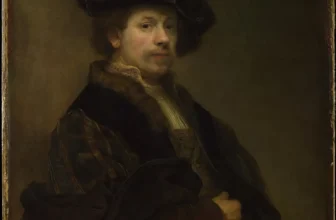Portrait of a Noblewoman by Lavinia Fontana: A Guide to History, Symbolism, and Meaning
| Invest in Hidden Masterpiece: Rare Antique Oil Paintings For Sale. Limited Originals Available 💰😊 Are you looking for authentic hidden masterpiece? Explore old master antique oil paintings from the Renaissance and Baroque eras. From 16th-century portraits to 18th-century landscapes. Authenticity guaranteed, Old Master antique oil paintings for sale. Shop Now! 🎨 Renaissance And Baroque Art Landscape Antique Paintings Old Master Portrait Paintings |
Among the masterpieces of late-Renaissance portraiture, Lavinia Fontana’s Portrait of a Noblewoman (c. 1580) stands out as an extraordinary fusion of elegance, craftsmanship, and cultural insight. Created by one of the earliest professional female painters in Western art, this work has long captivated collectors, historians, and lovers of antique paintings. It is not simply a portrait; it is a window into the elite world of 16th-century Italian aristocracy, where power, identity, lineage, and luxury were encoded visually through fashion, jewelry, and posture. Each detail, from the noblewoman’s elaborate gown to the small dog at her side, communicates a rich symbolic vocabulary typical of Renaissance portraiture.
Today, the painting resides in the Museum of Fine Arts, Houston (MFAH), where it continues to draw attention for its remarkable precision and its compelling representation of female status and self-presentation during the late Cinquecento. Whether you are a dedicated art collector, an admirer of Old Master paintings, or a specialist in Renaissance symbolism, this guide provides a comprehensive exploration of the painting’s historical context, artistic significance, and encoded meaning.
Lavinia Fontana: A Pioneering Woman in Renaissance Art
To appreciate Portrait of a Noblewoman, it is essential first to understand the exceptional career of its creator. Lavinia Fontana (1552–1614) was a groundbreaking figure in European art. Born in Bologna to a painter father, Prospero Fontana, she trained in his workshop and quickly developed a reputation for portraiture.
Fontana as One of the First Professional Female Artists
While women artists existed before Fontana, very few were able to sustain financially independent careers. Fontana was remarkable because she:
worked professionally for pay,
managed a thriving workshop,
received commissions from aristocratic and ecclesiastical patrons,
became official portraitist to important Italian families,
and produced an unusually high number of signed works for her time.
Her clientele included members of the Bolognese elite, papal circles in Rome, and noblewomen who desired formal, highly detailed representations of their status. This makes Portrait of a Noblewoman emblematic not just of aristocratic identity but also of Fontana’s pioneering place in art history.
Stylistic Signatures of Fontana
Fontana became renowned for:
meticulous rendering of textiles, embroidered fabrics, and jewelry,
sensitive depiction of hands and facial expression,
symbolic use of accessories commonly associated with female virtue,
and innovative inclusion of small domestic animals.
These characteristics define Portrait of a Noblewoman and contribute to its enduring appeal among collectors.
Historical Context: Italy in the Late 16th Century
The painting was created in the 1580s, during a period when Italy was a mosaic of duchies, city-states, and Papal territories. This era was marked by:
heightened attention to courtly etiquette,
strict codes of aristocratic self-presentation,
and increasing participation of noblewomen in cultural patronage.
Portraiture as a Social Currency
In Renaissance Italy, portraiture was not merely commemorative. It served specific social functions:
marriage arrangements: portraits could be used to introduce potential brides,
dynastic display: families showcased lineage and prestige through portraits,
political influence: imagery asserted alliances, wealth, and social rank,
documentation of status: clothing and adornments were visual indicators of privilege.
The sumptuous attire, luxury materials, and formal posture in Fontana’s painting align with these social conventions. The sitter’s identity remains unknown, but her clothing and accessories indicate that she belonged to a family of considerable wealth.
Bologna as a Center for Female Educated Culture
Bologna was unique in Renaissance Italy for supporting women’s education and artistic development. This progressive environment allowed Fontana to thrive and explained why Bolognese noblewomen often commissioned her to immortalize their status. Portrait of a Noblewoman, though typical of elite portraiture, also reflects Bologna’s specific cultural milieu where intellectual and artistic refinement were highly valued.
Description of the Painting: Visual Analysis for Collectors
While many Renaissance portraits focus primarily on the face, Fontana treats the entire figure, including clothing and accessories, as carriers of meaning. The painting features a young noblewoman standing against a dark background, her face calm, her posture dignified, and her attire exceptionally rich.
The Dress
The noblewoman wears a deep red gown embroidered with gold threads, a highly expensive fabric in the late 16th century. The vertical gold bands and ornate bodice emphasize balance and symmetry. The sleeves include a contrasting white and gold fabric, tightly patterned and indicative of aristocratic fashion.
Red was a color associated with:
wealth, due to the cost of dyes,
fertility, and
noble dignity.
Jewelry
The sitter is adorned with:
a gold necklace,
multiple ornate chains,
a jeweled belt,
earrings,
and possibly rings.
These pieces were not only fashion accessories, they signified:
familial wealth,
dowry value,
and sometimes marital status.
Fontana was famous for painting jewelry with extraordinary precision, making her portraits valuable references for historians of costume and ornamentation.
The Dog
One of the most endearing elements of the painting is the small white dog at the woman’s side. The dog raises its paws toward her, a gesture that adds dynamism to the otherwise formal composition. In Renaissance portraiture, dogs symbolized fidelity, loyalty, and domestic virtue.
For collectors, the inclusion of animals, especially small lapdogs, can significantly enhance the interpretive richness of a portrait, making this painting especially appealing.
The Dark Background
Fontana places the figure against a deep, almost black background. This compositional choice:
elevates the sitter’s importance,
highlights the texture and color of the clothing,
and reflects influences from northern European portraiture, which Fontana admired.
This contrast intensifies the luminosity of the gold embroidery and jewelry.
Facial Expression
The noblewoman’s expression is serene but reserved. Unlike later Baroque portraiture, which favored dramatic movement, this work maintains a sense of composed dignity. The slightly turned head and fair skin align with contemporary ideals of beauty.
Symbolism and Meaning: What the Painting Communicates
Every element in Portrait of a Noblewoman is intentional. Renaissance portraits encoded messages about:
virtue,
lineage,
marital status,
wealth,
and character.
Clothing as Social Code
During the Renaissance, sumptuary laws often restricted certain fabrics to the aristocracy. The noblewoman’s gown would have clearly communicated her high rank.
The symbolism of her clothing includes:
Red and Gold Embroidery: signifying wealth and aristocratic lineage.
Structured Silhouette: representing decorum and discipline.
Pearls or white jewels (if present): traditionally symbolizing purity.
Collectors familiar with Renaissance symbolism can read these garments as powerful social statements.
Jewelry as Identity Markers
Jewelry was among the most potent markers of status. The chains and pendants in this portrait likely had personal meaning, perhaps gifts, dowry pieces, or emblems associated with a noble house.
Additionally, elaborate jewelry could represent:
feminine virtue,
marital alliances,
and hereditary wealth.
The Dog as Allegory
Small dogs were favorites in aristocratic households. In portraiture, they symbolized:
loyalty (from the Latin fidelitas),
domestic virtue,
marital fidelity,
and occasionally companionate love.
The dog’s affectionate gesture toward the noblewoman humanizes the otherwise formal portrait and may hint at her gentle character.
Hand Gestures
The noblewoman’s hand resting calmly on the dog suggests control tempered with kindness. Her other hand holds what appears to be a glove or possibly a fan, objects associated with refinement, modesty, and noble bearing.
Hair and Headdress
Her elaborate hair arrangement adorned with flowers or jewels serves symbolic as well as aesthetic purposes. During the period, ornate hairstyles signified:
readiness for marriage,
high social status,
and adherence to courtly fashion traditions.
Artistic Techniques: Why Collectors Prize Fontana’s Work
Lavinia Fontana’s paintings are celebrated for technical mastery. Collectors value:
Precision in Textile Rendering
Fontana’s ability to reproduce fabric textures, particularly velvet, silk, lace, and brocade, is exceptional. This skill is especially apparent in the noblewoman’s dress. Such detail offers:
historical documentation of 16th-century fashion,
proof of the painter’s craftsmanship,
and visual richness that increases a work’s aesthetic and market value.
Balanced Composition
The centered figure, symmetrical dress patterns, and vertical lines create a harmonious, stable composition. These features make the painting visually timeless.
Subtle Modeling of Skin
Despite the heavily adorned clothing, Fontana handles the noblewoman’s face with remarkable delicacy. The soft gradations of light across her skin reflect a mastery of chiaroscuro.
Cultural and Historical Authenticity
Collectors value paintings that accurately reflect their era. Fontana’s works are treasure troves for historians because she faithfully recorded clothing styles, jewelry, hairstyles, and Renaissance interiors.
Provenance and Current Location
Portrait of a Noblewoman is housed in the:
Museum of Fine Arts, Houston (MFAH)
Houston, Texas, USA
The painting entered the collection through acquisition and is part of the museum’s European art holdings. As an authenticated work of Lavinia Fontana, whose oeuvre is smaller than those of many male Old Masters, the painting is considered a rare and extremely valuable example of female-produced portraiture from the Renaissance.
Collectors often regard museum-held works as touchstones when evaluating private-market pieces, making this portrait a reference point for understanding:
Fontana’s technique,
her stylistic evolution,
and the aesthetic norms of her clientele.
Why This Painting Matters to Collectors and Scholars
Lavinia Fontana is increasingly recognized as a foundational figure in Western art history. Consequently, her works, and especially those in excellent condition, are achieving growing market interest and scholarly attention.
Rising Recognition of Women Old Masters
The art world has seen a surge in appreciation for female artists of the Renaissance and Baroque periods, including Sofonisba Anguissola, Artemisia Gentileschi, and Lavinia Fontana. Fontana, often overshadowed, is now emerging as essential to the narrative.
Rarity and Quality
High-quality, securely attributed works by Fontana are relatively rare. The level of execution in Portrait of a Noblewoman demonstrates her artistic maturity and mastery of detail.
Cultural Significance
The painting is an important artifact of early female professional achievement and represents a major stage in the evolution of European portraiture.
Appeal to Antique-Art Enthusiasts
The work’s combination of luxury fashion, symbolic elements, and refined craftsmanship makes it especially compelling for collectors of:
Renaissance art,
portrait miniatures and full-length portraits,
aristocratic iconography,
and paintings featuring animals in symbolic roles.
What the Painting Ultimately Represents
At its core, Portrait of a Noblewoman is an ode to feminine dignity, aristocratic culture, and Renaissance ideals of beauty and morality. It embodies:
continuity of lineage,
celebration of female virtue,
economic and political power,
and the evolving role of women in Renaissance society.
Though the sitter remains unidentified, her portrait has achieved immortality through Fontana’s artistry. The work illustrates the paradox of Renaissance noblewomen, individuals of high status yet constrained by strict social codes. Fontana captures not only the opulence of their lives but the quiet strength, poise, and humanity behind their formal presentation.
A Masterpiece of Symbolism, Identity, and Renaissance Aesthetics
Lavinia Fontana’s Portrait of a Noblewoman remains one of the most beautifully executed and symbolically rich aristocratic portraits of the late 16th century. Its fusion of exquisite detail, sophisticated symbolism, and historical authenticity makes it a key work for understanding:
Renaissance elite culture,
gender roles in early modern Italy,
the evolution of European portraiture,
and the groundbreaking contributions of women artists.
For collectors, historians, and enthusiasts of antique paintings, this portrait offers an exceptional example of how art communicates identity, power, and elegance. Today, preserved in the Museum of Fine Arts, Houston, it continues to inspire admiration and scholarly inquiry, testifying to the enduring legacy of Lavinia Fontana as one of the Renaissance’s great portraitists.





